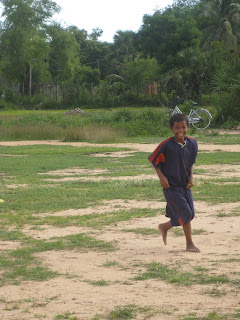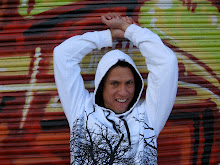
I was on the BART train today and saw that of the several dozen people in there, no one was interacting. We put up paper and electronic walls to isolate themselves -newspapers, iPhone earbuds, email on our Blackberries - our heads are down and we concentrate hard not to acknowledge the person only two feet to our left.
I close my eyes and I'm back in Cambodia, paddling down a river in the mid-day sun. I'm alone, but I'm without walls (rivers and Blackberries don't mix). I interact with the water, with the folks on the banks, with the world. I dip my paddle and slowly pull. Dip, dip, pull.
It's the oldest story. Hero sets out for adventure, faces trials, slays monsters, returns home to discover everything he needed was within him all along. Its the Epic of Gilgamesh, the Ramayana and Frodo. It's the adventure cliché that we expect - the hero returns, far from triumphant, but graceful, humbled and wise. It gives our story the good smooth finish like sea glass or an old cabernet. I'm not sure my story has the good finish. I'm not sure my story is finished at all. Maybe I'm ending a chapter.
"So did you find what you were looking for?" is the question I get most often. I don't know. But here are some of the things I found.
1. Friends
Traveling alone impels one to connect with people in a way that just doesn't happen when traveling with company. The sole traveler is more open, accessible and vulnerable. I delighted in the company of loving, honest and wickedly fun people who opened themselves up to help me along this journey; Sarah, who made me part of her family in Leyte; Migs, whose sharp wit made even getting robbed seem fun; Mikey and Japz of the monthsaries, night caps and a great despidida; Da who helped me scratch through a few of the complicated layers of Cambodia; Tito Mancio and Tita Aide whose magical hospitality charmed me into falling in love with the island of witchcraft; the beautiful staff and children at the orphanage in Siem Reap who I visit often in dreams. Most especially, I am grateful to my dear friend Jose who spent countless hours with me sweating out last night's cocktails in the Manila heat, navigating the boatways and busways of Luzon and the Visayas, and explicating the nuances of a culture at once so familiar, so foreign and so ours. Because of Jose, I better understand the Philippines and myself.
2. Poverty
Poverty informs every aspect of life and society in the third world. Like family connection, or a sense of shame, its an invisible force present in every interaction, even if our western sensibilities are not attuned to it. On this trip, I experienced deeper, darker sides of life that have everything to do with the hardship of the have-nots.
In Palawan, I made a friend who also served as my guide. One afternoon, we stopped by the hotel room of some new friends of mine, wealthy Filipinos who were enjoying merienda on their lanai. I walked up to greet them and sat down. My friend stayed standing on the grass below. An invisible wall of place and class barred him from crossing three steps.
I wasn't blind and deaf to poverty before. I've worked with youth in low-income neighborhoods my whole life. But experiencing the third world is a different animal. My eyes are open wider and my commitment is steeling. I've spent the first fourteen years of my career focusing on youth and education; on helping kids to escape. I'm not sure that's enough anymore. Instead of helping pockets of young people to jump a social class, maybe we can impact poverty itself. I've been reading economics books, researching fields like micro-finance, and I've grown to a point where I'm naive enough to think that there are means within capitalism to eliminate destitute poverty within my lifetime. I'm not sure exactly what this means for me, but its time to roll up my sleeves.
3. Sleep
Before I left for Asia, I was in a bad state. I allowed my confidence to be pulled apart. I was flailing, unmoored, erratic and bitchy. Worst of all, I became insomniac. When sleep left, I felt like a school boy spurned by my first lover. Each night I lay down exhausted, but when I closed my eyes, my brain wouldn't shut off. I'd obsess about irrelevant details. I'd replay hard interactions at work. I'd imagine confrontational conversations, and these hallucinated interactions produced as much anger, frustration and stress as the real thing. When I got out of bed in the morning, I had no idea how much, if any, sleep I had achieved. Days were spent in a zombie state. Fatigue hampered my ability to produce and to think. Over time, the difference between my waking and slumbering hours diminished. I was up at night and sleepwalking during the day. I never felt clear or focused. When you can't sleep, you can't think. When you can't sleep, you can't heal.
I finally found solace in a sleeping pill and a glass of shiraz each night. Sleep, once again, pushed through the chatter and nestled over me. But I hated relying on drugs for anything but the occasional fun night. When I got to Asia, I panicked, realizing that I had no sleeping pill prescription. I panicked until the first night when I lied down on Jose's spare futon and slept hard for 10 hours. Throughout my time in Asia I slept like it was a hobby, an art form. I experimented with positions - back, stomach, fetal, or cramped drooling in the back of a jeepney. I slept like a breakdancer spins or a magician deceives, with bravado, flair and invention. I became well acquainted with both the siesta and the mid-morning nap. Well rested, I started to feel like myself again.
4. Confidence
I don't know why I let a situation at work completely knock me off my game. Slowly, as I worked my way through Southeast Asia, I began to believe in myself again. There's something about figuring out a strange world alone that makes me know I can do anything. I learned how to eat crickets. I made friends without having a common language. I navigated Manila traffic. I played in monsoons, coached soccer in a foreign language and lasted six weeks without decent coffee. And I learned, once again, that drag queens and mosquitoes find me irresistible. The main thing about traveling alone is that ultimately there's no one else. I had to figure things out myself. Getting robbed twice and losing my wallet sucked, but afterward, I felt a little bit like a badass. I got robbed in a third world country and got through it okay! What have you accomplished today?
5. Love
It was Chris who nudged me to take this trip. I knew I needed to leave my job, but the responsible thing to do was to find another job. Finally, he pushed me to resign knowing that it took all my strength and courage to just do that. It was Chris who convinced me to go to Asia, knowing that I needed to relax, recover and search. I'm very independent (unless the Mac isn't working right or I can't find my keys, and then I'm reduced to a tantruming eight year old). When Chris stepped up to support me, emotionally and financially through this transition, I realized how deep his sense of commitment and purpose is. For the first time, ever, I let some of my independence go. It's still scary. But it made me realize that we are more than boyfriends or co-habitators or whatever. We're like, a real family.
I'm seated on a kayak, slowly meandering down a river in Battambang. Physically, it's quite easy. The river does the work. I use the paddle, dip, dip, pull, to guide my passage. White cows on the bank pause in their grazing to observe me. Naked children wave and I paddle over, dip, pull, and kids climb aboard the kayak for a few minutes. Its near the end of my trip, both on the river and in Asia. I try to push my thoughts toward my career. I don't have a job or a clear direction when I return to California. Okay, Ed, what do you want to do with your life? The answer comes instantly, clearly and unexpectedly.
I want to be a dad.
6. Peace
So I'm back at home and I'm trying to figure out a few things. I've been getting consulting work and that will allow me to pay some bills, but also have the flexibility to focus on my writing. I'm not sure what kind of writing I want to do, but doing this blog has brought back a voice that has been missing. I want to keep this voice speaking. When fatherhood comes, and I hope that's soon, I'll be able to work my schedule around our family needs. Chris and I met with our adoption agency last week to start the process again. I've been getting a lot of work and I haven't even told people that I'm looking. That makes me confident. I want to use consulting as a way to dabble, experiment and build new skills. Much like a third world bus ride, I'm getting on with a sense of destination, but knowing that it could change and there will be many stories along the way. I want to do work that re-imagines healthy experiences for youth and families. I want to work to end poverty. How does that all work with the desire to start a family? I have no idea. That doesn't matter. For once, I'm chill. I can operate without a script and trust that it will all work out. I can just move with the river. Dip, dip, pull; children, career change, love, making a difference in the world, it can all happen in due time and I don't have to figure it all out today.
I still have a sense of wanderlust and adventure. I know myself well enough to know that this pull will never go away. But right now the adventure is at home. The clever north wind guided me for the last few months. Perhaps you know the end to the quotation that continues to guide me.
"But still the clever north wind was not yet satisfied. It spoke of towns yet to be visited, friends in need yet to be discovered, battles yet to be fought...
by someone else, next time. "


























































